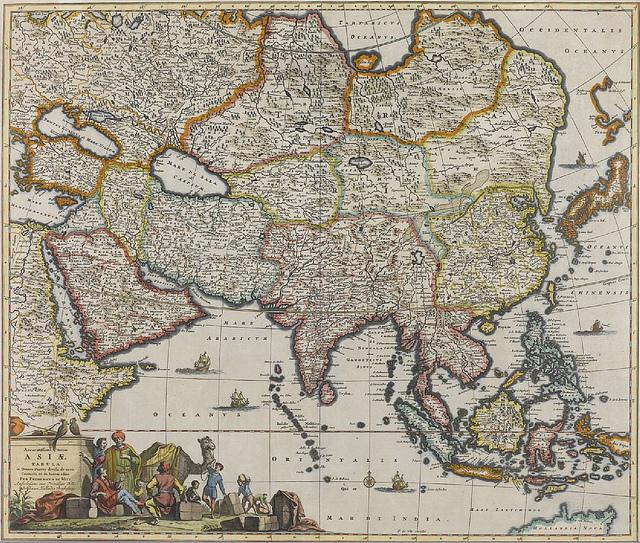Integrated Asia: Australia’s biggest strategic policy challenge in 75 years
Posted By Nick Bisley on July 4, 2017 @ 14:30
I recently argued that Asia is becoming a coherent strategic system [1]. This system is centred on the gravitational force of China’s growing geo-economic and strategic weight but also bound together by growing trade and investment flows, and, with the Belt and Road Initiative and other institutional structures, underpinned by a nascent multilateral architecture. The once discrete systems of Northeast, Southeast, South and Central Asia are becoming the most important strategic system in world politics.
In this post I will explore three significant strategic policy challenges that the integration of Asia into a singular strategic system present. Together they represent the biggest change Australia has faced in its history as an independent actor in international affairs.
First, the most important feature of Asia’s strategic order, as it existed for the four decades after Sino-American rapprochement, was the stability of its power balance. The US was the predominant power and no other country had the interest, will or capacity to challenge its position. That allowed the countries of Asia, including Australia, to spend a good deal less on defence and security than would otherwise have been the case.
The emerging integrated Asian strategic system will be very different. It will be comprised of a small number of very large and powerful states, none of whom will be able to command the kind of predominance that the US enjoyed previously. The US will remain powerful but its relative advantage will be reduced.
China will have greater weight through its increased military capability, the connectivity created by the Belt and Road Initiative will reduce its vulnerability to maritime predation and increase its strategic depth. A more powerful and confident India will be the third corner of the major Asian power play, with others, such as Japan and Indonesia, becoming important players but at the margins of influence.
The biggest challenge for Australia will be to work out how to position itself in this contested strategic setting. Does Australia steadfastly cling to one side? Should it give itself flexibility to play sides off against one another? Or should it opt out of the contest and take advantage of its geography to remain aloof from integrated Asia’s geopolitical and geo-economic contest? The key question policy-makers need to address today is how the country can give itself options to advance its strategic interests in a bigger, more complex strategic setting and one which will be in stark contrast to the stability of the previous four decades.
Second, the US alliance remains the bedrock of Australian international policy. It presented a strikingly good deal for Australia in terms of relative benefit to cost but it also reflected a close alignment between Australian interests and values. As well as a very different strategic balance, integrated Asia significantly changes the alignment of interests and values and the relative costs and benefits of the alliance to Australia.
That’s not to say the alliance should be ditched or that it’s completely anachronistic. Rather, it’s to emphasise that as US power and influence decreases, and as Australia’s interests in the strategic order diversify, Australian strategic planners need to recognise that the value calculation of the alliance will change.
In its current configuration, the alliance comes with side costs that could prove significant in the future and warrant careful consideration. Central to that is the limits the alliance places on strategic maneuverability. While secondary powers are dependent on the actions of the most powerful, in contested orders their relative position in the system can be increased as they’re able, if they choose, to leverage larger contestation to their strategic advantage.
To do that, Australia would need to loosen its current relationship with Washington. If it weren’t to go down that path then Australia should expect that it will need to investment more, financially, politically and operationally, into its relationship with the US to sustain the same return for its strategic policy.
In either scenario Australia is almost certainly going to face higher costs and greater risks in integrated Asia.
Third, related to the integration of Asia is the waning of the liberal order—the only one Australia has navigated as an independent power. Its decay is being presaged by the coalescing of a coherent Asian geopolitical and geo-economic system. And this new strategic system will be much less conducive to the liberal ideas that have been vital both to Australia’s political and economic life at home and its international engagement abroad. The processes creating an integrated Asian order defined by contestation among major powers are bringing geopolitics back to centre stage. But power alone won’t be the only issue for Asia’s big players to fight about.
Australia has recently placed heavy emphasis on the value of the liberal order and its importance to its strategic interests. Already it’s clear that there’s a mismatch between the rhetorical commitment to the importance of the order and the action which the country is prepared to take to defend it. As integrated Asia coheres into a contested strategic system, those ideas will be much more openly at stake and Australia will need either to stiffen its spine and work to defend those ideas in a much less permissive international environment. Alternatively, it will need to be prepared to recognise that interests and power have become more important than rules and values.
While integrated Asia promises a great deal—human development will continue to be advanced at a high rate and links between states and peoples will continue to grow—it also brings considerable new risks. The first step in managing those risks is recognising the nature and scale of change Australia faces. It will be like nothing this country has ever seen.
Article printed from The Strategist: https://aspistrategist.ru
URL to article: /integrated-asia-australias-biggest-strategic-policy-challenge-75-years/
URLs in this post:
[1] strategic system: http://sdsc.bellschool.anu.edu.au/sites/default/files/publications/attachments/2017-05/cog_integrated_asia-may_2017_0.pdf
Click here to print.
